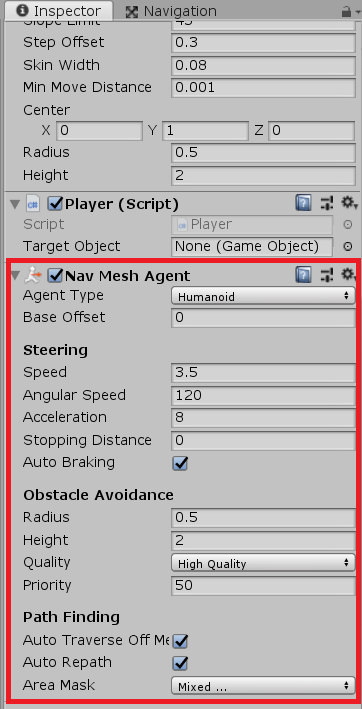

A rectangle and circle shape is built in, but you can also specify a custom mesh to use. The NavmeshCut component uses a 2D shape to cut the navmesh with. With navmesh cutting you can remove (cut) parts of the navmesh that is blocked by obstacles such as a new building in an RTS game however you cannot add anything new to the navmesh or change the positions of the nodes. Recast graphs usually only allow either just changing parameters on existing nodes (e.g make a whole triangle unwalkable) which is not very flexible or recalculate a whole tile which is pretty slow. Navmesh cutting is used to cut holes into an existing navmesh generated by a recast graph.
#Unity navmesh unwalkable how to
Areas and Costs – learn how to use different Area types.Navmesh cutting is used for fast recast graph updates.
#Unity navmesh unwalkable full
Bake Settings – full description of the NavMesh bake settings.Creating a NavMeshAgent – learn how to allow your characters to move.This can be convenient if you don’t happen to have the Navigation Window open. In addition to marking objects as Navigation Static in the Navigation Window‚ as explained above, you can use the Static menu at the top of the inspector A Unity window that displays information about the currently selected GameObject, asset or project settings, allowing you to inspect and edit the values. Additional Workflows for Marking Objects for Baking For example, if you have a scene called First Level in the Assets folder, the NavMesh will be at Assets > First Level > NavMesh.asset. When baking is complete, you will find a NavMesh asset file inside a folder with the same name as the scene the NavMesh belongs to. The side effect of the approximation is that sometimes you will need to have a little extra space in your level geometry to allows the agent to pass through a tight spot. This is done in order to keep the NavMesh data size small. This can be seen for example in the stairs which are represented as a flat surface, while the source surface has steps. However, the point interpretation allows for better runtime efficiency and also allows the designer to see immediately whether an agent can squeeze through gaps without worrying about its radius.Īnother thing to keep in mind is that the NavMesh is an approximation of the walkable surface. Conceptually, it doesn’t matter whether you regard the agent as a point on a shrunken NavMesh or a circle on a full-size NavMesh since the two are equivalent. The NavMesh represents the area where the center of the agent can move.

The resulting NavMesh will be shown in the scene as a blue overlay on the underlying level geometry whenever the Navigation Window is open and visible.Īs you may have noticed in the above pictures, the walkable area in the generated NavMesh appears shrunk.

More info See in Glossary can be done in 4 quick steps: In each Scene, you place your environments, obstacles, and decorations, essentially designing and building your game in pieces. Think of each unique Scene file as a unique level. In Unity, NavMesh generation is handled from the Navigation window (menu: Window > AI > Navigation).īuilding a NavMesh for your scene A Scene contains the environments and menus of your game. More info See in Glossary that approximates the walkable surfaces of the level. Nurbs, Nurms, Subdiv surfaces must be converted to polygons. Unity supports triangulated or Quadrangulated polygon meshes. Meshes make up a large part of your 3D worlds. More info See in Glossary of all Game Objects which are marked as Navigation Static, and then processes them to create a navigation mesh The main graphics primitive of Unity. A Terrain GameObject adds a large flat plane to your scene and you can use the Terrain’s Inspector window to create a detailed landscape. The process collects the Render Meshes and Terrains The landscape in your scene. The process of creating a NavMesh from the level geometry is called NavMesh Baking.


 0 kommentar(er)
0 kommentar(er)
